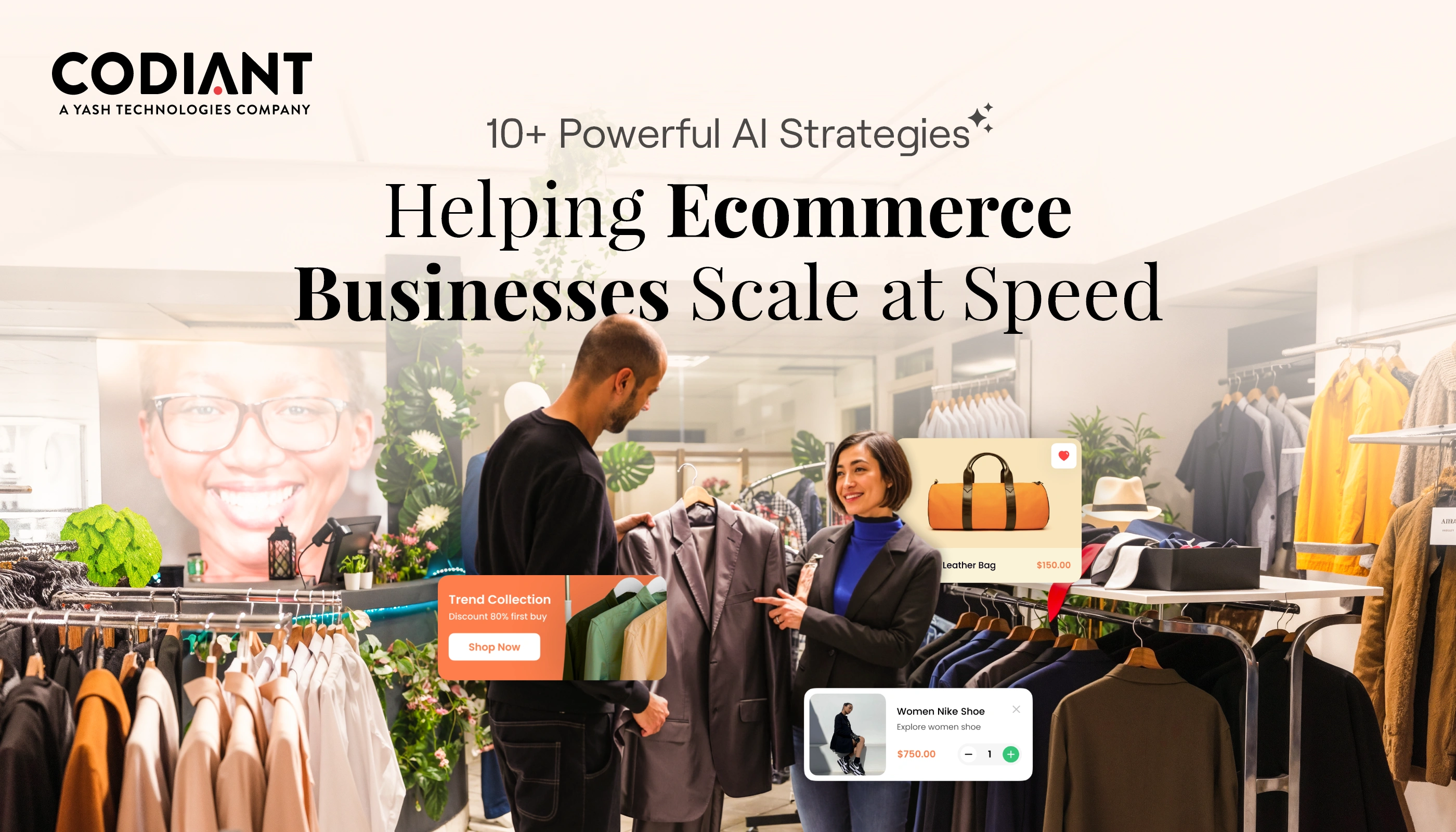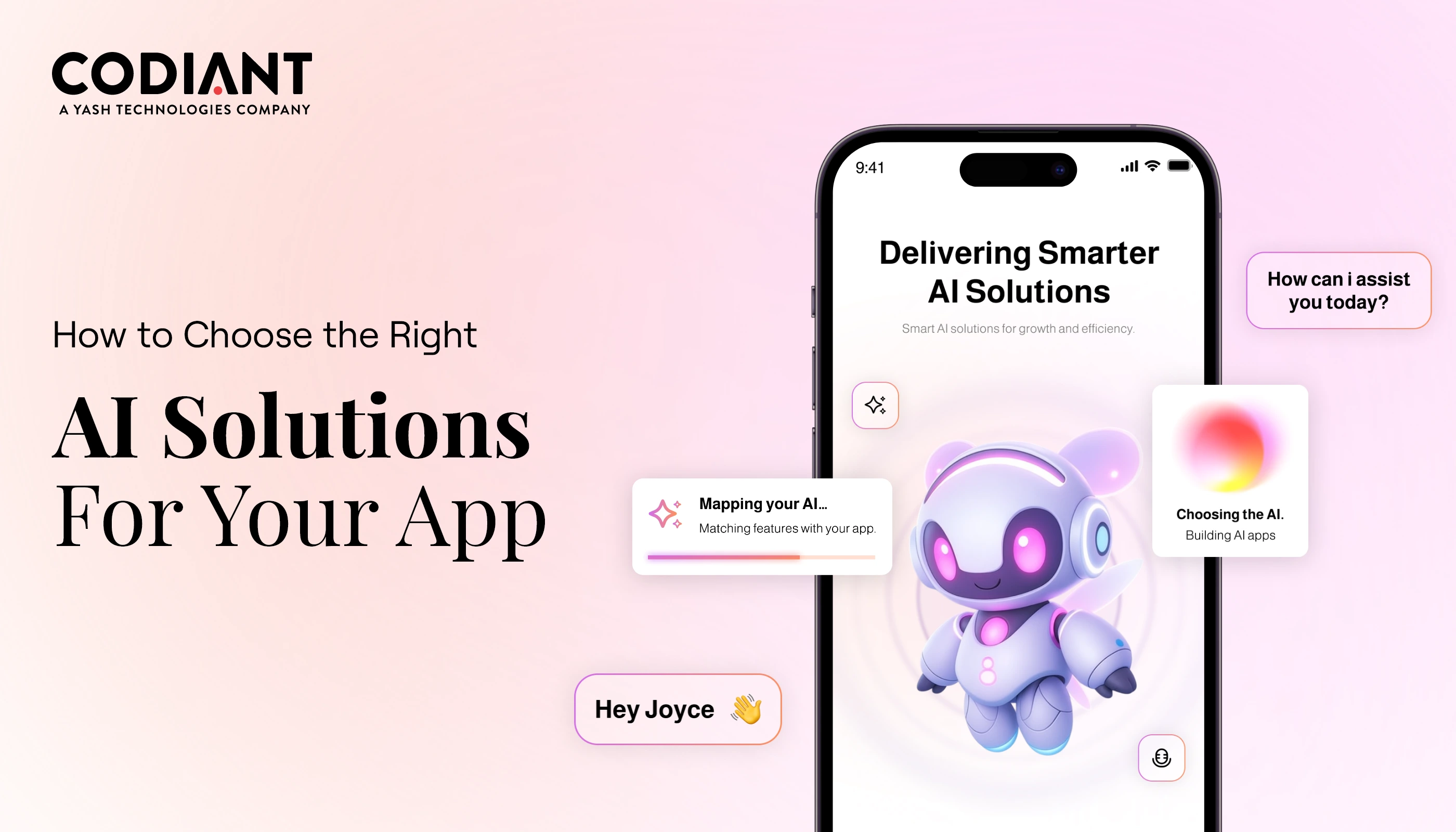How to Integrate AI in Recruitment and Cut Hiring Time by 70%
Table of Contents
Subscribe To Our Newsletter
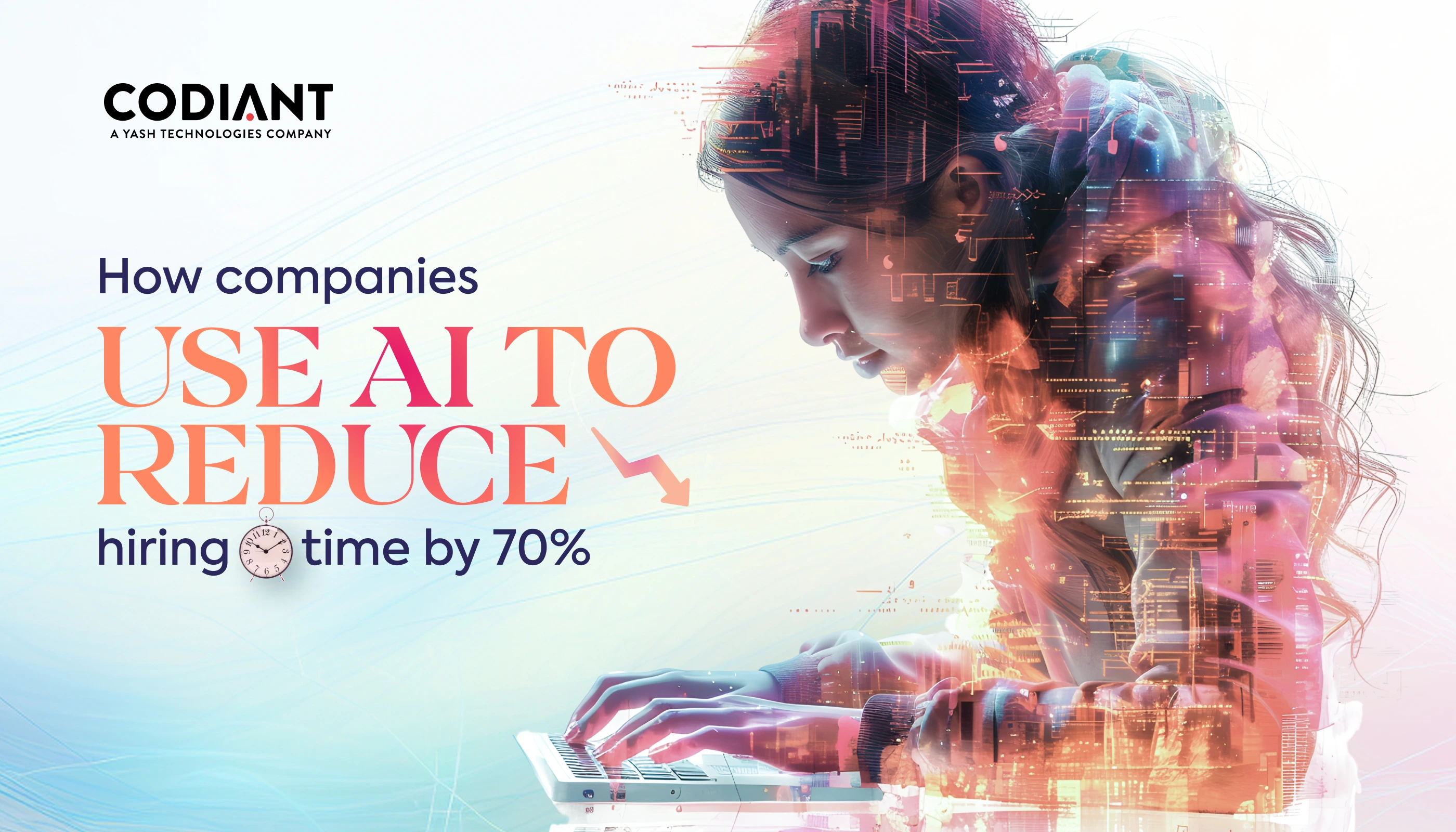
Recruiting teams face a clear operational challenge: too much manual work and not enough qualified talent reaching the finish line. Even with modern ATS systems, most hiring workflows still depend on human-driven screening, coordination, and evaluation steps. The result is long hiring cycles, rising costs per hire, and frequent talent drop-off.
AI recruitment automation directly targets these constraints. By embedding intelligence into sourcing, evaluations, and decision-making, organizations can reduce time-to-hire with AI while improving hiring accuracy. Instead of adding more recruiters, companies are shifting to AI-powered hiring processes that can parse skills, rank candidate-job fit, and trigger next steps automatically.
This shift is accelerating. By 2026, AI hiring platforms are expected to become core infrastructure in talent acquisition, not supplementary tools. The new standard is an AI-based recruitment platform that integrates seamlessly with existing HR systems and automates candidate screening with AI at scale.
The question is no longer why integrate AI in recruitment but how to implement it in a way that drives measurable efficiency and speed. This blog examines the most effective strategies, integration models, and results companies are already achieving globally.
Understanding the Time-to-Hire Problem
Hiring has become slower while business demands are becoming faster. Across the globe, companies are struggling to move candidates efficiently from sourcing to offer acceptance. The result is longer delays and higher talent acquisition costs.
Hiring Timelines Are Increasing Across Industries
Research shows:
- Global average time-to-hire: 38–45 days
- Technical and specialist roles: 55–70 days
- Highest delays: US, Canada, Western Europe
- Fastest cycles still slowing: APAC, Middle East
The longer an open position remains unfilled, the deeper the impact:
- Lost productivity and delayed project deliveries
- Increased workload on existing employees
- Higher risk of losing qualified candidates to competitors
Every day of delay can cost $500–$1,000 for a critical role.
How to Integrate AI into Existing Hiring Systems
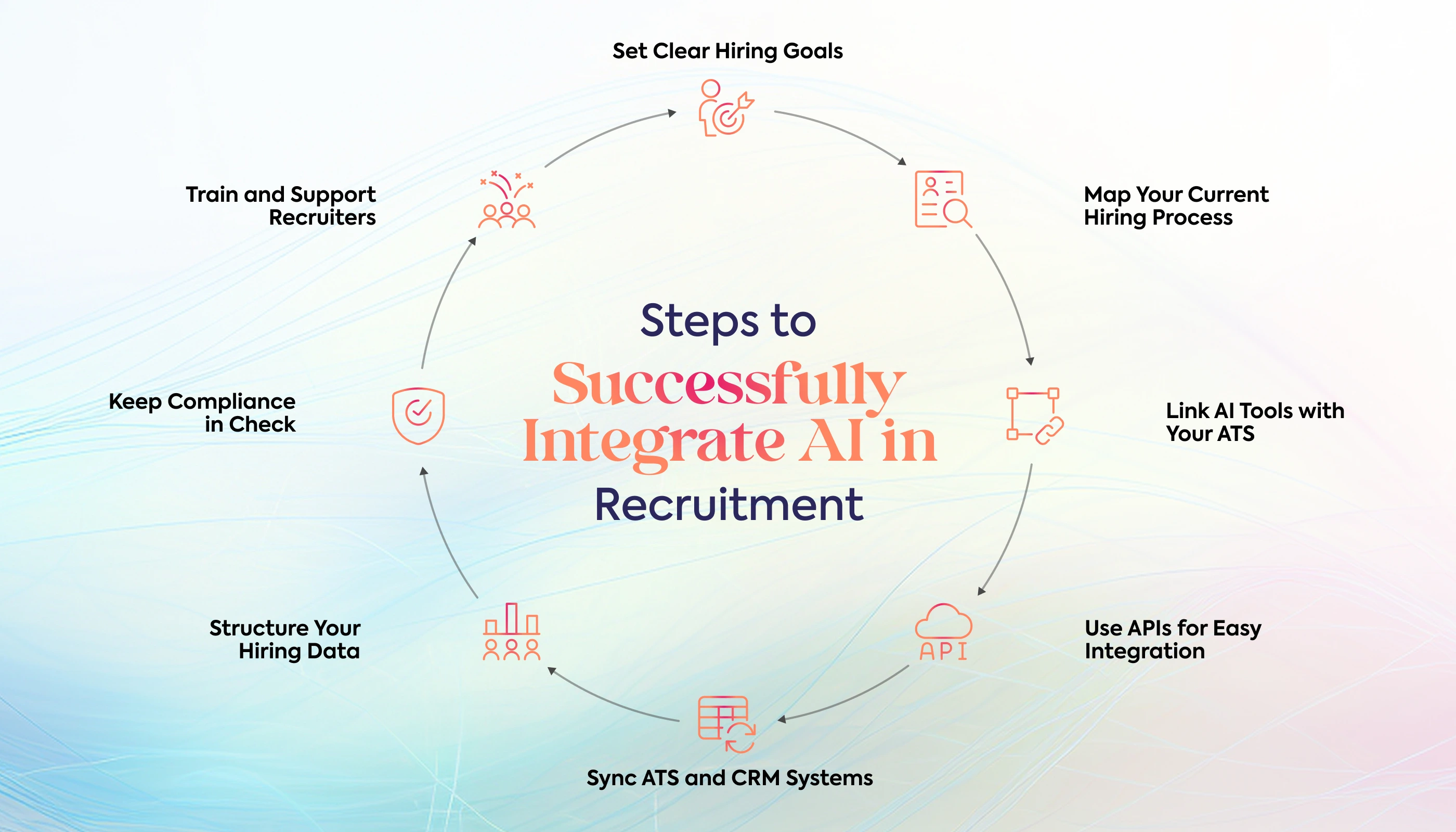
As organizations accelerate digital transformation across HR, the biggest operational advantage lies not simply in purchasing AI tools but in how effectively those tools are integrated within the existing talent acquisition (TA) ecosystem. When AI works in isolated silos, the hiring process continues to experience delays, fragmentation, duplicated work, and inconsistent decision-making. However, when AI is embedded seamlessly across sourcing, screening, interviewing, and onboarding systems, hiring timelines can shrink dramatically often by 60–70%.
Effective integration requires a structured approach that considers business objectives, data interoperability, technology compatibility, and organizational readiness. Below is a comprehensive AI recruitment integration guide that explains how to integrate AI in recruitment without disrupting ongoing operations.
Cut Hiring Time. Slash Costs. Scale Smarter.
Companies using AI recruitment automation are already seeing:
1. 70% faster hiring cycles.
2. 35–45% lower hiring costs.
3. 3X recruiter productivity boost
4. 60% quicker sourcing-to-offer timelines
It’s time to let AI do the heavy lifting from screening to scheduling.
Start automating your recruitment today with HireGroww.
1. Define Clear Recruitment Goals
Every successful AI-powered hiring process begins with clarity of purpose. Companies must define measurable recruitment outcomes before choosing tools or technologies. While most TA teams aim to reduce time-to-hire, the strategic goals often differ by business maturity and hiring volume.
Examples of defined goal categories:
| Goal Category | Focus | Sample Metrics |
| Speed | Shortlist faster | Time-to-screening reduced by 70% |
| Efficiency | Minimize manual tasks | Recruiter hours saved per role |
| Quality | Better fit and lower turnover | First-year attrition drop |
| Inclusivity | Remove bias | Diversity improvements |
| Scale | High-volume hiring | Screening capacity per recruiter |
Without well-defined outcomes, AI adoption risks becoming an expensive experiment.
Key actions for alignment:
- Identify bottlenecks impacting hiring cycle length
- Map where automation yields the highest ROI
- Prioritize workflows where human intervention adds limited value
- Create governance boundaries to retain recruiter judgment where needed
A strategic outcome-driven approach ensures AI remains a value multiplier not a replacement for human decision-makers.
2. Map Your Current Hiring Process
Before integrating AI, you need a complete picture of how your current hiring ecosystem works. Begin by documenting every stage of the recruitment journey, from candidate sourcing and application intake to screening, interviews, offer management, and onboarding.
Create a visual workflow (using a simple flowchart) that shows:
- Which tools or systems are used at each stage (ATS, CRM, HRIS, email, spreadsheets).
- How data moves between them where it’s stored, shared, or duplicated.
- Points where human intervention slows down decisions or creates manual rework.
Once the process is mapped, analyze bottlenecks such as repeated data entry, fragmented candidate communication, or unstructured feedback loops. These ga ps reveal where AI automation can deliver the highest impact like resume parsing, screening, interview scheduling, or feedback summarization.
This mapping step builds the foundation for integration, ensuring your AI deployment aligns with existing workflows rather than disrupting them. It’s how you prepare your organization to move from reactive hiring to a seamless, intelligence-driven process.
3. Connect AI with Your ATS
An Applicant Tracking System remains the operational core of recruitment. Most AI tools deliver real impact only when fully integrated into the ATS workflows where hiring decisions are managed.
Key integration touchpoints:
- Resume ingestion and automated candidate screening
- Ranking candidates by job-match score
- Intelligent candidate rediscovery from talent database
- Skill-based tagging and segmentation
- Automated interview scheduling triggers
- Status updates synced in real time
Even high-performing AI tools lose efficiency if recruiters manually import candidate data or switch between multiple systems. Full ATS integration prevents:
- Duplicate data entry
- Screening delays
- Fragmented talent insights
- Compliance conflicts due to inconsistent record keeping
Modern AI solutions typically offer plug-in connectors for widely used ATS platforms (Workday, Greenhouse, iCIMS, Taleo, Lever). For legacy ATS, middleware integration or custom APIs may be required.
Success Criteria:
- 100% data synchronization across systems
- Automated rules for stage progression
- AI recommendations always visible within ATS interface
This helps transition AI from a supportive add-on into a core hiring enabler.
4. Automate Hiring with APIs
Application Programming Interfaces (APIs) act as the connectivity layer enabling scalable AI recruitment automation. Instead of replacing existing HR infrastructure, APIs allow organizations to build a modular, future-ready tech stack.
Advantages of API-based integration:
- Plug-and-play compatibility with existing platforms
- Faster deployment with minimal downtime
- Lower IT overhead compared to infrastructure replacement
- Ability to integrate new AI capabilities over time
Typical automation capabilities enabled via APIs:
- Automated resume parsing into structured skill datasets
- Job-candidate matching completed in seconds
- Automated communication via chatbots, WhatsApp, email, and SMS
- Workflow automation for candidate stage transitions
- Real-time talent analytics dashboards
APIs empower HR teams to modernize the hiring experience with AI while retaining their current HRMS, ATS, or CRM systems, reducing cost and change resistance.
Read More: How to Hire a Dedicated Development Team? All You Need to Know.
5. Sync AI Across ATS and CRM
Beyond ATS, many organizations rely heavily on a Candidate Relationship Management (CRM) system to engage passive and future talent pipelines. AI transforms traditional CRM workflows into proactive, intelligence-driven talent engagement engines.
Capabilities unlocked by AI-driven CRM:
- Talent rediscovery: surfacing high-potential candidates overlooked earlier
- Personalized nurture campaigns based on role, skills, and behavior
- Predictive job-fit scoring for future openings
- Automated alerts for candidates nearing hiring readiness
- High-volume pre-screening for seasonal or bulk recruitment
When integrated with ATS:
- CRM takes ownership before application stage (pipeline generation)
- ATS manages post-application workflow (process execution)
- AI acts as the intelligence fabric orchestrating both sides
This dual-platform intelligence dramatically speeds up movement from sourcing to hiring, enabling organizations to fill roles faster and protect revenue opportunities associated with talent shortages.
6. Structure Your Hiring Data
AI systems operate on structured data. Many traditional hiring systems, however, store resumes as unstructured documents that are difficult to analyze. A successful integration requires a unified data model that represents skills, job requirements, candidate history, and performance indicators accurately.
Core initiatives required:
- Skill Taxonomy Standardization
Establish consistent naming for technical, cognitive, and behavioral skills to ensure accurate matching.
Example:
“Java Developer” → Backend, Java, Spring Boot, Microservices
- Competency-Based Job Descriptions
Replace vague bullet points with measurable skill requirements:
- Required proficiency level
- Years of experience
- Certification relevance
- Continuous Data Enrichment
AI refreshes candidate profiles using:
- Updated skills from public data
- Certifications and learning progress
- Career advancement indicators
When data consistency improves, AI-driven hiring becomes:
- Faster (no screening ambiguity)
- More accurate (predictive ranking improves)
- Fairer (bias from subjective resume interpretation reduced)
7. Maintain Compliance and Fairness
As AI takes a stronger decision-making role, maintaining compliance becomes both complex and essential. Organizations must ensure that every automated recommendation remains legally defensible and ethically fair.
Key governance actions:
Bias Monitoring Controls
- Benchmark AI recommendations against diversity targets
- Detect unintended discrimination in model outcomes
Auditability
- Full visibility into why a candidate was shortlisted or rejected
- Time-stamped logs of AI scoring rationale
Regulatory Alignment
Global frameworks impacting AI hiring:
- EEOC (U.S.) – Anti-discrimination enforcement
- GDPR (EU) – Data privacy protections for job applicants
- AI Act (EU upcoming) – High-risk system compliance requirements
- Local labor/hiring regulations in APAC, India, GCC
Human-in-the-Loop Design
Recruiters retain final decision authority for sensitive steps:
- Final shortlist approval
- Culture and behavioral fit assessment
- Compensation finalization
AI must bring efficiency without compromising fairness or legal obligations.
8. Train and Empower Your Team
Even the most advanced AI-powered hiring process fails if recruiters resist adoption. Many HR leaders underestimate the cultural and behavioral shift required when automation replaces high-touch manual activities.
To accelerate acceptance, organizations must:
- Provide comprehensive tool enablement
- Communicate AI’s role as a productivity multiplier
- Redefine KPIs focusing on outcomes instead of effort
- Introduce new skill expectations (analytics, data interpretation)
- Establish feedback channels for continuous refinement
Recruiter role evolution:
| Traditional Role | AI-Augmented Role |
| Administrative operations | Data-driven hiring strategist |
| Manual screening | Human judgment on top-scoring candidates |
| Repetitive coordination | Relationship building with top talent |
| Decision intuition | Evidence-based hiring outcomes |
When recruiters experience workload reduction and better hiring outcomes, AI becomes a welcomed innovation rather than a perceived threat.
Final Analysis
Integrating AI into existing recruiting systems requires more than technology adoption. It demands strategic alignment, interoperability frameworks, responsible governance, and strong change management.
Top measurable impacts:
- 70% faster hiring cycles
- 50–60% fewer manual tasks
- 3X candidate pipeline efficiency
- Improved hiring accuracy and retention
By transforming ATS and CRM into a unified, intelligence-driven recruitment ecosystem, organizations can create a truly scalable, AI-powered hiring process that delivers sustainable competitive advantage in the global talent market.
Transform Your Hiring with Smart Automation
Get a personalized roadmap to automate sourcing, screening, and scheduling with AI.
The Role of AI in Talent Acquisition
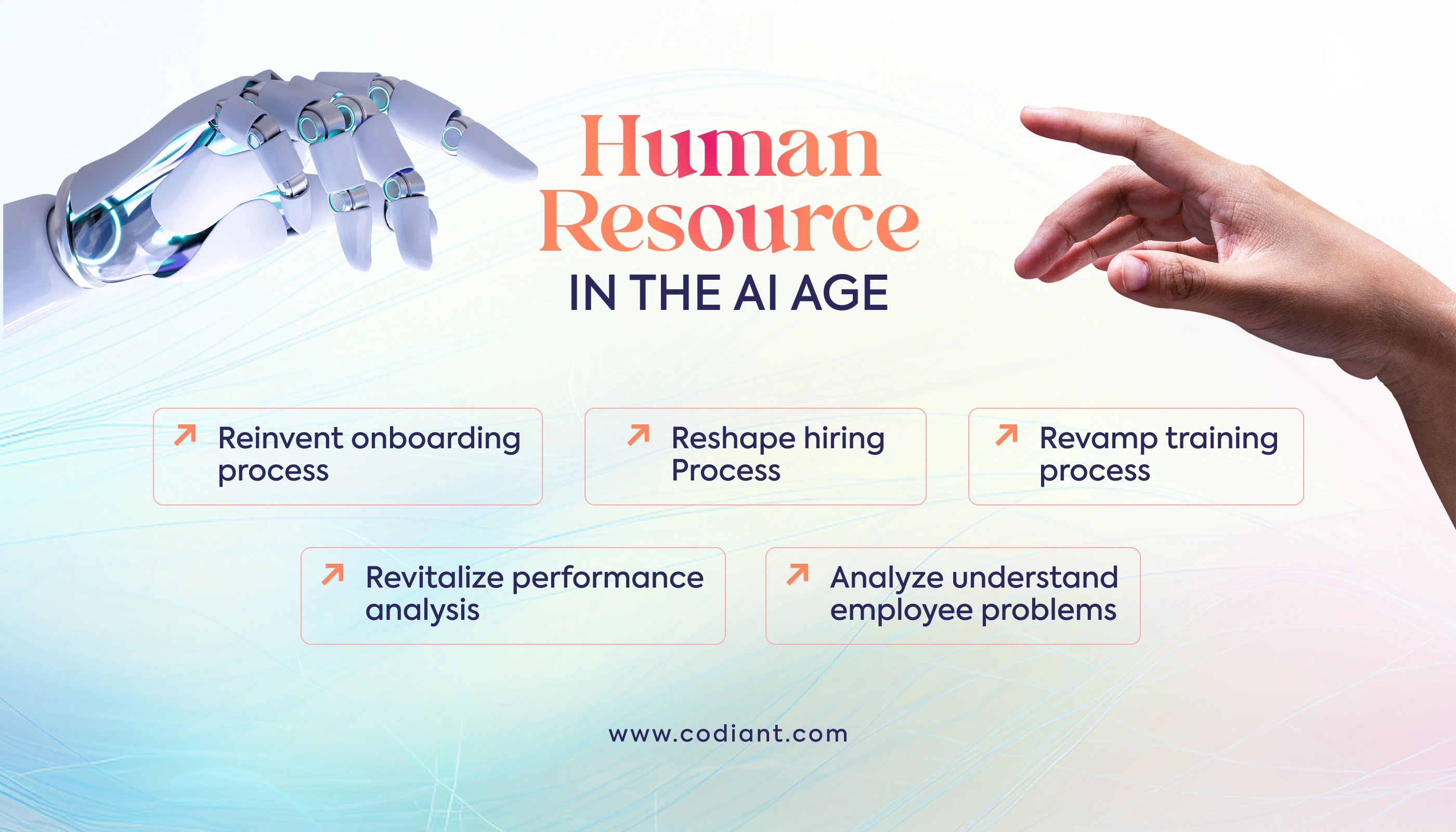
Recruitment has long been constrained by manual effort screening thousands of profiles, coordinating interviews, writing structured evaluations, and making informed decisions based on incomplete data. As businesses scale globally and skills evolve rapidly, traditional hiring processes struggle to keep pace. This is where Artificial Intelligence is fundamentally transforming talent acquisition by increasing speed, expanding reach, improving accuracy, and reducing dependency on human bandwidth.
AI does not replace recruiters — it amplifies their ability to operate strategically. Instead of spending hours on repetitive tasks, TA teams can now focus on candidate relationships, employer branding, and ultimately delivering greater business value.
How AI Enhances Each Stage of the Recruitment Funnel
1. Intelligent Sourcing
AI sourcing engines proactively identify talent by scanning:
- Job boards
- Career websites
- Social profiles (LinkedIn, GitHub, Behance)
- Internal talent databases
Unlike keyword-based searching, AI recognizes contextual skill relationships — for example, a DevOps engineer may not mention “Kubernetes,” but experience in cloud orchestration suggests proficiency.
Impact on hiring:
- Up to 40% faster pipeline generation
- Improved candidate diversity due to broader reach
- Increased access to passive talent (who form >70% of the market)
AI expands talent pools beyond what recruiters can manually discover.
Example in Action: The HireGroww platform demonstrates how AI interprets candidate data to generate a Job Fit Analysis showing overall match scores, strengths, and skill gaps for precise role alignment.
Illustration: AI-driven Job Fit Analysis dashboard in HireGroww highlighting smart recommendations and skill-gap insights.
2. Automated Candidate Screening with AI
Traditional screening consumes 30–40% of a recruiter’s effort. AI replaces this bottleneck by instantly evaluating candidate suitability using:
- Skill matching and semantic search
- Work history comparisons
- Role-specific scoring models
- Automated elimination of unqualified profiles
Instead of reviewing 200+ resumes manually, recruiters immediately receive a shortlist of top 10–15 profiles.
Example in Action: The HireGroww AI screening interface (shown below) instantly filters hundreds of profiles using semantic matching and role-fit algorithms — allowing recruiters to view only the most relevant candidates in seconds.
Illustration: AI-powered candidate search view in HireGroww showing smart filtering, skill-based search, and instant shortlist generation.
Read More: Staff Augmentation vs. Outsourcing: Which One Is Right for Your Business in 2025?
How can AI reduce hiring time in the recruitment process?
By removing manual screening delays and administrative friction:
- Shortlisting time reduced from weeks to minutes
- Automated scheduling eliminates back-and-forth communication
- Decision workflows run in parallel rather than sequentially
This significantly accelerates movement from application → interview → offer, reducing time-to-hire by up to 70% in high-volume hiring environments.
3. AI-Powered Assessments & Interview Automation
AI-driven testing and video intelligence tools evaluate:
- Technical and domain knowledge
- Behavioral and cognitive traits
- Communication and situational response
- Culture and team fit indicators
Capabilities include:
- Automated proctoring to prevent cheating
- Asynchronous interviews for global scalability
- Real-time scoring with benchmark accuracy
By structuring evaluations around objective metrics, AI increases selection consistency and reduces subjective interpretation.’
Example in Action: The HireGroww Video Interview Analysis module (shown below) demonstrates how AI evaluates candidate responses across professionalism, attitude, communication, and sociability, providing a complete picture of performance through visual and transcript-based insights.
Illustration: AI-powered interview analysis interface in HireGroww showing live video response, automatic transcript generation, behavioral trait scoring, and overall candidate comparison.
4. Predictive Hiring Analytics
AI transforms hiring from an intuition-based decision into a data-driven strategy. Predictive models analyze:
- Skills adjacency and future role fit
- Career growth potential
- Historical hiring outcomes
- Performance correlation indicators
Recruiting becomes more proactive:
- Identify talent risks early
- Forecast pipeline gaps
- Recommend sourcing channels with highest ROI
Predictive analytics shifts talent acquisition into an engine for long-term workforce planning.
How does AI improve the accuracy of candidate selection?
Because AI evaluates actual performance predictors, not superficial resume cues:
- Objective scoring based on measurable competency
- Historical performance patterns inform selection
- Consistent evaluation standards across all candidates
The result is higher recruiter confidence and better new-hire performance.
5. Compliance, Bias Reduction & Decision Intelligence
One of the most valuable yet often overlooked advantages of AI lies in structured fairness controls. AI monitors:
- Patterns of rejection and selection
- Algorithm-driven bias detection
- Audit trails for transparent hiring decisions
Governance tools ensure:
- Ethical automation aligned with global regulations (GDPR, EEOC)
- Built-in checks to reduce unconscious bias
- Candidate decisions validated through explainable models
Recruiters retain the final decision authority, supported by ethically aligned automation.
Read More: How to Reduce Developer Recruitment Costs?
What Are the Measurable Benefits of Using AI in Hiring?
| Benefit Area | KPI Impact | Evidence from Deployments |
| Speed | Reduces time-to-hire by 50–70% | Faster screening and automated interview coordination |
| Efficiency | Improves recruiter productivity by 2–4 times | High-volume roles managed efficiently without burnout |
| Quality | Increases first-year retention by 25–50% | Better candidate-job fit supported by competency scoring |
| Diversity | Improves representation by 10–20% | Reduced influence of unconscious bias in shortlisting |
| Cost | Lowers cost-per-hire by 30–50% | Reduced dependency on manual sourcing and agencies |
| Scalability | Expands hiring throughput by up to 3 times | Bulk recruitment handled without additional headcount |
These measurable results demonstrate clear business ROI transforming talent acquisition into a strategic growth driver.
What Drives a 70% Faster Hiring Timeline with AI?
Reducing time-to-hire has become a global priority for organizations competing for scarce, high-performing talent. Manual workflows from resume screening to interview coordination create bottlenecks that directly harm revenue, productivity, and candidate experience. AI disrupts this slow and fragmented model by transforming hiring into an intelligent, automated, and insight-led process.
Below are the core operational accelerators that enable companies to reduce time-to-hire with AI by up to 70%, while improving quality of hire and recruiter productivity.
1. Workflow Automation Replacing Manual Tasks
One of the most immediate benefits of AI in recruitment is the elimination of repetitive, low-value administrative work. Traditional processes require recruiters to manually parse resumes, evaluate profiles, schedule interviews, and follow up with candidates — tasks that consume over 50–60% of recruiter time.
AI deploys automation at every step:
- Resume parsing and skill extraction occur in seconds
- Job matching algorithms rank best-fit candidates instantly
- Chatbots respond to queries and qualify applicants 24/7
- Offer letters and background checks are auto-triggered via workflows
This shift enables hiring teams to focus exclusively on high-impact interactions such as candidate relationship management and final assessment, not administrative effort.
2. Reducing Shortlist Time from Weeks to Hours
Traditional hiring cycles often stall at the shortlisting stage, particularly in high-volume or highly specialized hiring scenarios. Recruiters spend days or weeks manually reviewing resumes to create a qualified shortlist.
With AI:
- Intelligent screening filters and scores candidates against skill taxonomies and job requirement models
- Predictive job fit scoring prioritizes candidates most likely to succeed in role
- Talent rediscovery identifies previously rejected applicants who now match new positions
Organizations report that shortlisting efforts that once took 2–3 weeks can now be completed in under 24 hours.
Example KPI Impact:
| Metric | Traditional Process | AI-Powered Hiring Process |
| Time to screen 500 applications | 40–60 hours | < 30 minutes |
| Recruiter review per CV | 180 seconds | 10 seconds (automated scorecard) |
| Quality shortlists created | 1–2 per role | 5+ per role |
This acceleration dramatically increases candidate acceptance rates, since top talent is engaged before competing employers extend offers.
3. Speeding Up Interview Scheduling
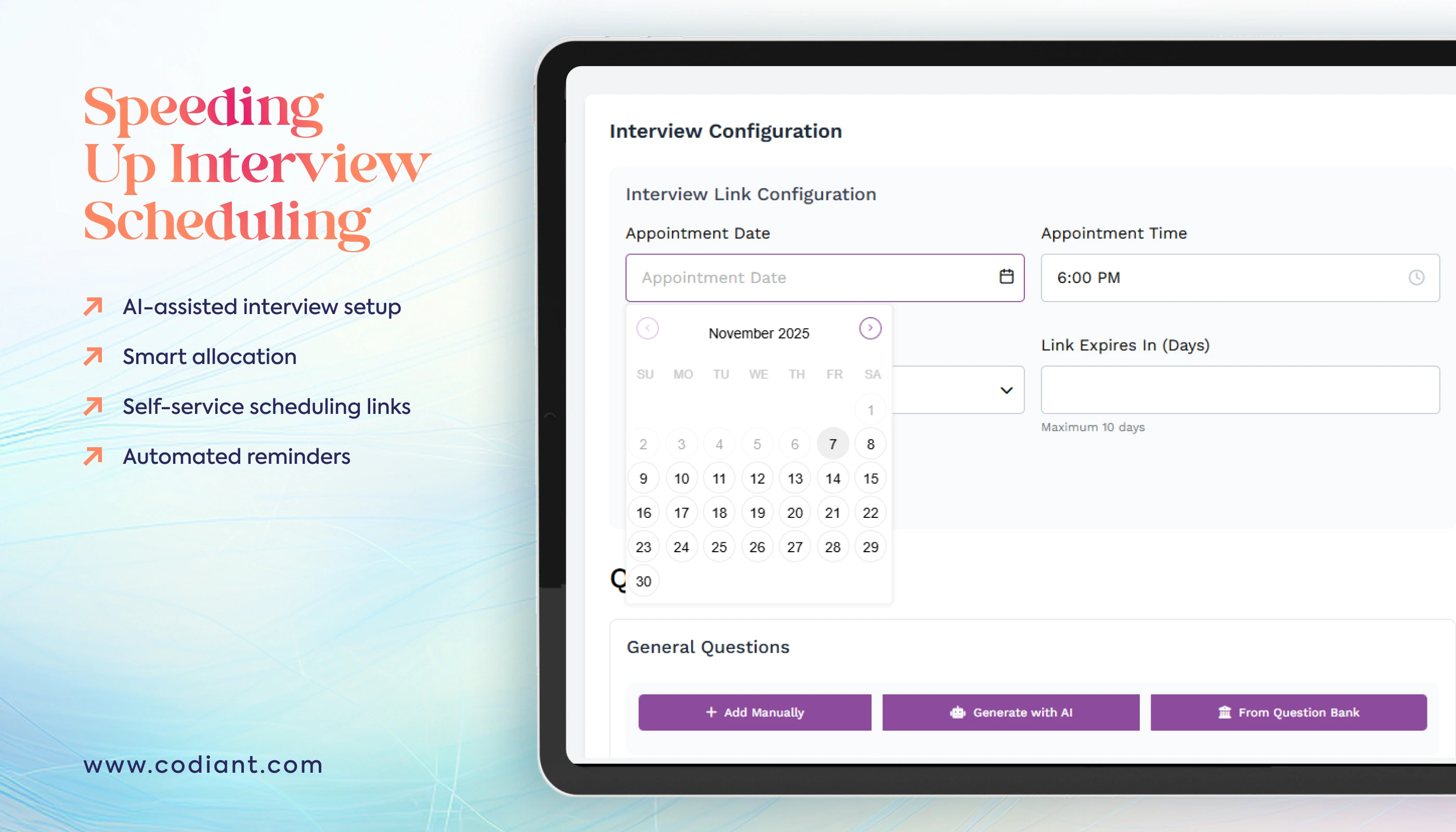
Interview delays are one of the most costly friction points. An interview slot mismatch of just 2–3 days can push hiring timelines back by 2–3 weeks when multiple rounds are required.
AI solves this with:
- AI-assisted interview setup with configurable date, time, and expiry options
- Smart allocation based on interviewer availability + role urgency
- Self-service scheduling links for candidates
- Automated reminders to reduce interview drop-offs and no-shows
Example in Action: The HireGroww Interview Configuration interface (shown below) enables recruiters to set appointment details, define expiry rules, and even auto-generate interview questions using AI—cutting coordination time from hours to minutes.
Illustration: AI-powered interview setup screen in HireGroww, streamlining manual scheduling with smart date selection and automated question generation.
Enterprise case studies show:
- 50–80% reduction in interview gaps
- 40% drop in no-shows due to automated reminders
This is a crucial enabler in how to speed up hiring process using AI at enterprise scale.
4. Data-Driven Decisions → Faster Approvals
Traditionally, shortlists move slowly because hiring approvals rely heavily on subjective judgment and manual stakeholder alignment. This creates delays, inconsistencies, and bias.
AI introduces structured evidence into every decision:
- Skills-based scorecards
- Culture-fit indicators
- Predictive performance analytics
- AI-powered red-flag checks
This drives:
- Faster consensus from hiring committees
- Reduced re-evaluation cycles
- Improved confidence in selection quality
Executives gain visibility into hiring decisions through:
- Real-time dashboards
- SLA tracking
- Compliance logs
Approvals accelerate because every recommendation is backed by measurable proof — not guesswork.
5. Cross-System Collaboration via AI-Driven ATS Integration
The hiring cycle slows dramatically when HR systems operate in silos requiring recruiters to manually transfer data between ATS, CRM, HRMS, email tools, and background verification platforms.
AI-driven ATS integration eliminates this fragmentation by:
- Syncing all hiring data across platforms in real time
- Triggering automated workflows as soon as criteria are met
- Preventing duplication and inconsistencies
- Creating communication transparency across hiring stakeholders
This is a fundamental component of digital transformation in HR, allowing hiring to function like a fully connected, intelligence-driven supply chain.
AI Tools Used in the Recruitment Process Today
The rapid evolution of HR technology is continuously redefining modern talent acquisition. Instead of relying solely on recruiter effort and manual workflows, organizations are adopting an ecosystem of AI-driven solutions that operate across sourcing, screening, interviewing, assessment, and decision-making.
These AI tools for recruiters are not only accelerating hiring velocity but also increasing precision in talent matching by analyzing skills, behaviors, and performance indicators at scale.
Below is a breakdown of the ten most impactful AI tool categories transforming the recruitment process worldwide:
1. AI-Powered Screening Systems

AI-based screening platforms instantly analyze candidate data, generate role-fit profiles, and surface insights like skills, certifications, and performance growth.
Key capabilities include:
- Pattern recognition in resumes and profiles
- Skill and experience mapping
- Behavioral and cultural fit scoring
- Elimination of duplicate profiles
These systems help recruiters focus their attention exclusively on shortlisted, role-ready candidates—cutting screening time from weeks to minutes.
Example in Action: The HireGroww Candidate Profile Dashboard (shown below) illustrates how AI converts unstructured resumes into structured, insight-rich profiles—complete with performance ratings, skill growth metrics, and project-based achievements.
Illustration: AI-generated candidate overview in HireGroww highlighting experience, skill growth, certifications, and key projects—all automatically extracted and scored for recruiter efficiency.
2. Resume Parsing & Semantic Matching Engines
AI-powered resume parsing tools use NLP to convert unstructured resumes into structured profiles with fields like:
- Work experience
- Education
- Certifications
- Technical competencies
Semantic matching ensures that resume content is interpreted by meaning rather than keyword frequency. This allows recruiters to eliminate false positives and uncover highly relevant profiles that may not use standard terminology.
3. Automated Sourcing & Talent Market Intelligence
AI sourcing platforms continuously scan:
- Job boards
- Career websites
- Public forums
- Professional networks
The systems proactively suggest potential candidates who are most likely to respond, reducing reliance on job postings.
They also provide:
- Market talent availability analytics
- Competitor hiring patterns
- Compensation benchmarking
This enables data-driven workforce planning and proactive talent pipeline development.
5. Video Interviews with AI-Assisted Evaluation
AI-enabled video interview tools enhance interview standardization by analyzing:
- Communication patterns
- Micro-expressions
- Language clarity and tone
- Technical knowledge accuracy
Live and asynchronous models ensure screening consistency and reduce interview bias. Recruiters save up to 80% of pre-screening effort while gaining deeper insight into candidate behavior.
6. AI-Driven Skill & Technical Assessment Platforms
These tools conduct:
- Cognitive and behavioral evaluations
- Domain-specific technical tests
- Coding challenges
- Situational judgment assessments
Machine learning helps determine skills-to-job fit, predicting real-world performance more accurately than CV-based evaluation alone. This replaces outdated assessment methods with structured, scalable, secure evaluation processes.
6. Background Verification Automation
AI-enabled background verification automates one of the most time-intensive stages of recruitment ensuring authenticity, compliance, and trust at scale.
- Identity verification
- Criminal and employment history
- Education validation
- Digital footprint analysis
Continuous monitoring ensures risk reduction even after onboarding critical for regulated industries like finance, healthcare, and logistics.
Example in Action: The HireGroww Resume Red Flag & Authenticity Audit (shown below) uses AI to cross-check timelines, detect inconsistencies, and flag potential risks across areas like job history, skills alignment, and educational verification.
Illustration: AI-powered resume authenticity audit in HireGroww showing automatic detection of timeline inconsistencies, unverifiable credentials, and credibility checks for listed employers.
7. Talent Rediscovery & Internal Mobility Intelligence
Hiring teams often overlook valuable past applicants and internal talent. AI leverages existing ATS databases to:
- Rediscover qualified silver-medalist candidates
- Recommend internal workforce redeployment
- Align talent skills with emerging roles
This reduces cost-per-hire and hiring dependency on external pipelines.
8. Offer Automation & Compensation Intelligence
AI-powered offer engines streamline:
- Offer approvals
- Compensation modeling
- Compliance with statutory guidelines
- Forecasting offer acceptance probability
These tools shorten negotiation cycles and prevent candidate drop-offs caused by delayed offers.
9. Job Description Intelligence & DEI Optimization
AI platforms analyze job descriptions to identify:
- Biased vocabulary and tone
- Overly restrictive requirements
- Skills that reduce applicant diversity
They also auto-generate inclusive, SEO-optimized content, leading to wider sourcing funnels and higher-quality applicant pools.
10. Talent Analytics & Workforce Productivity Platforms
These systems connect data from the entire hiring lifecycle to provide visibility into:
- Time-to-hire improvement
- Recruiter productivity metrics
- Quality-of-hire indicators
- Predictive workforce needs
Organizations gain real-time operational control while ensuring hiring remains aligned with business demand.
Read More: Choose The Right Staff Augmentation Model For Your Business
Strategic Value of an AI Recruiting Tech Stack
| Objective | AI Value Contribution |
| Reduce time-to-hire | Automation removes manual bottlenecks |
| Improve quality-of-hire | Competency-based matching & insights |
| Increase recruiter efficiency | High-volume tasks handled by AI |
| Enhance DEI & compliance | Bias monitoring & inclusive content |
| Optimize hiring spend | Fewer agency costs, reduced workload |
Real-World Case Examples: AI Transforming Hiring Outcomes Globally
Organizations across industries are validating the business case for AI in talent acquisition. While the level of adoption varies, measurable improvements in recruiter productivity, cost efficiency, and time-to-hire show a consistent pattern across markets. The following global benchmarking examples illustrate how AI-led transformation accelerates hiring success at scale without referencing individual product names or vendor promotions.
1. Enterprise Benchmark: End-to-End Workforce Automation
A multinational technology organization deploying AI across sourcing, assessment, and scheduling workflows recorded:
- 68% reduction in time-to-hire within 180 days
- 1x increase in recruiter throughput
- 35% lower early attrition due to better fit scoring
The greatest impact came from automated candidate screening and AI-assisted interviews, which allowed recruiters to reallocate focus from administrative tasks to candidate experience and stakeholder alignment.
2. Mid-Market Benchmark: Intelligent Screening to Replace Manual Filters
A regional financial services group facing skill shortages digitized resume evaluation and pre-screening tasks.
Results achieved:
- Hiring cycles shortened from 45 days to 18 days
- Recruiter workload reduced by 52%
- Enhanced diversity metrics due to structured evaluation
AI-based decision models helped identify skills adjacency, enabling the organization to hire high-potential candidates with transferable skills. Productivity gains were realized without adding more recruiters.
3. Manufacturing Sector Benchmark: High-Volume Hiring Optimization
A global manufacturing enterprise optimized frontline hiring by integrating AI assessments with mobile-first candidate workflows:
- 70% faster hiring for shop-floor roles
- 40% drop in interview no-shows
- 25% cost savings vs agency-driven recruitment
Automated engagement nudges improved completion rates and ensured precision in evaluating operational skills highly valuable in surge hiring cycles.
4. Healthcare Talent Acquisition Benchmark: Compliance with Speed
A hospital network leveraged AI-driven role matching and digital verification to accelerate clinician onboarding:
- Background check completion times cut by 60%
- Clinical role fulfillment reduced from 90 days to 36 days
The organization improved staffing resilience and avoided revenue leakage driven by prolonged talent shortages, especially in critical care units.
5. Global Retail Benchmark: Seasonal Workforce Agility
A top retail chain with seasonal workforce fluctuations adopted AI sourcing and rapid virtual screening:
- 50% faster seasonal staffing
- 92% candidate satisfaction score for mobile-first interviews
- Improved redeployment rates for past workers
AI rediscovery tools used historical talent data to prioritize pre-verified candidates, eliminating repetitive hiring cycles.
Real-World Examples
Forward-thinking companies across the globe are using AI recruitment technology to remove bottlenecks, make faster hiring decisions, and improve candidate experience. Here’s how industry leaders are putting AI to work:
LinkedIn – Smarter Matches for Jobs & Talent
LinkedIn’s AI engine continuously analyzes skills, profiles, and hiring patterns to recommend the right candidates for the right roles. The platform’s adaptive algorithms learn from user behavior, helping employers discover hidden-fit talent while job seekers receive highly personalized job recommendations.
IBM – Data-Driven Behavioral Assessment
IBM integrates AI analytics, including its own Watson technology, to evaluate behavioral patterns, communication traits, and culture fit. By predicting long-term success and job performance, IBM reduces hiring risks and builds teams that thrive.
Codiant – AI-Powered Skill-Based Hiring with HireGroww
Codiant leverages its in-house platform HireGroww, an AI-driven recruitment and pre-employment testing solution, to streamline hiring for technology and enterprise clients. HireGroww automates resume parsing, smart interview distribution, and AI-based candidate evaluation – helping companies reduce time-to-hire by up to 70% while ensuring fair, skill-based hiring decisions at scale.
Mastercard – High-Volume Screening Made Efficient
With thousands of applications flowing in, Mastercard uses AI-powered screening tools to instantly evaluate resumes against job requirements. This accelerates the first round of selection and ensures hiring managers only spend time on the most qualified profiles, ultimately improving hiring accuracy.
How Can Businesses Use AI in Recruitment Processes?
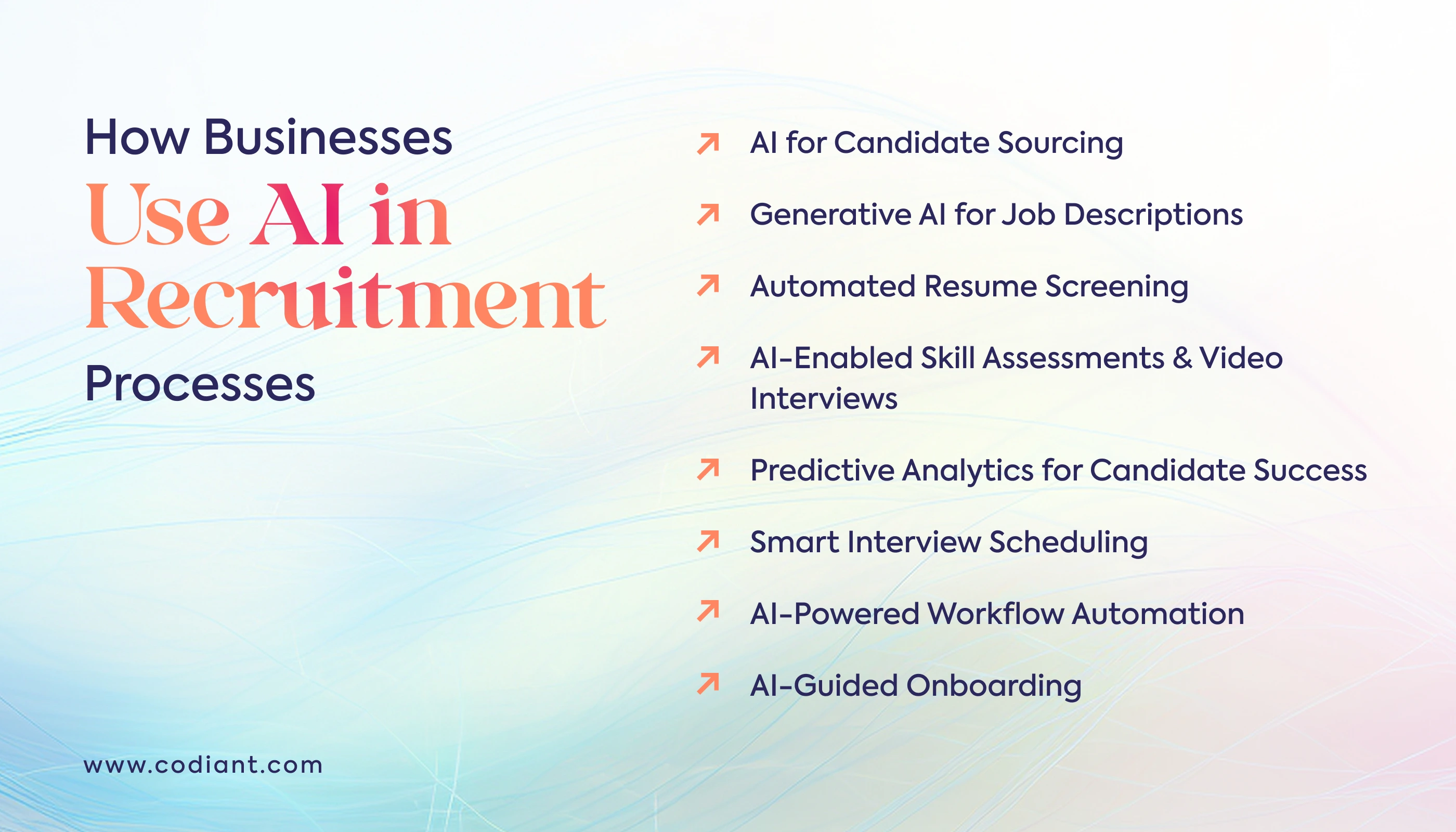
Businesses can use AI in recruitment processes to eliminate bottlenecks, reduce hiring delays, and improve selection accuracy. When exploring how to use AI in recruitment process frameworks, organizations typically integrate intelligent automation across the entire candidate lifecycle.
1. AI for Candidate Sourcing
Automates identification and outreach to qualified profiles across job boards, talent networks, and internal databases.
Outcome: Faster pipeline development with less manual effort.
2. Writing Job Descriptions with Generative AI
AI analyzes top-performing roles, market data, and required competencies to create inclusive, optimized job descriptions.
Outcome: Attracts better candidates and reduces bias in wording.
3. Automated Resume Screening & Shortlisting
Machine-learning models parse resumes and match candidates based on skills relevance, past performance indicators, and job criteria.
Outcome: Shortlisting time drops from weeks to hours.
4. AI-Enabled Skill Assessments & Video Interviews
AI evaluates communication patterns, behavioral cues, and skill-test responses for consistent and unbiased scoring.
Outcome: More accurate hiring decisions without interviewer variation.
5. Predictive Analytics for Candidate Success
AI forecasts job performance, cultural alignment, and retention probability using historical hiring and workforce data.
Outcome: Improved quality-of-hire and reduced early attrition.
6. Efficient Interview Scheduling
Virtual assistants and automation tools sync calendars, manage availability, and send automated reminders.
Outcome: Eliminates back-and-forth scheduling and speeds decision cycles.
7. AI-Powered Workflow Automation
Automates communications, document processing, and feedback collection throughout the hiring journey.
Outcome: Recruiters focus more on high-value human interactions.
8. Streamlined Onboarding Processes
AI-guided onboarding portals automate document submission, training assignments, role-based access, and learning paths.
Outcome: Faster ramp-up time and better new-hire experience.
Challenges & Risks HR Teams Must Consider Before Implementing AI in Recruitment

While AI is becoming foundational to modern talent acquisition, HR leaders must approach adoption with careful governance. Introducing automation into the hiring process impacts workflows, decision-making, and workforce dynamics meaning risks must be understood and mitigated early.
Below are the most critical challenges that Chief HR Officers and Talent Acquisition leaders should evaluate before integrating AI recruitment solutions.
- Algorithmic Transparency
AI-powered hiring decisions must be explainable. If an AI model rejects a candidate or assigns a low match score, recruiters need visibility into the rationale behind it.
Black-box systems can lead to compliance issues, candidate distrust, and operational challenges when decisions are disputed.
Transparent AI governance frameworks including audit logs, model logic explanations, and decision traceability are essential to maintain accountability and legal defensibility.
- Over-Automation Risk
While automation can reduce hiring time by up to 70%, not every step of recruitment should be machine-run.
Over-automation risks depersonalizing candidate experience and removing strategic human judgment where it matters most such as cultural alignment, leadership potential, and high-impact hiring decisions.
The optimal model is human-centric AI, where technology handles repetitive tasks, while recruiters remain responsible for final evaluations and relationship-building.
- Bias Monitoring and Fairness Audits
AI systems trained on historical hiring data can inadvertently reinforce existing biases for example, over-prioritizing elite institutions, certain demographics, or job titles common in legacy workforces.
Regulations such as the EU AI Act and various local equal employment laws increasingly require ongoing bias analysis. HR teams must deploy continuous fairness checks, risk scoring, and third-party audits to ensure AI systems do not create discriminatory outcomes.
- Data Privacy and Regulatory Compliance
Recruitment involves large volumes of personal and sometimes sensitive information including identity, assessments, video interviews, and employment records.
Integrating AI tools expands risk exposure across data storage, access, and cross-border transfer. Compliance with frameworks including GDPR, CCPA, and local labor regulations is non-negotiable.
Encryption, role-based access control, and clear data retention policies reduce privacy vulnerabilities while ensuring lawful processing.
- Skills Shift for Recruiters and HR Teams
AI will not replace recruiters but it will redefine their capabilities. As automation handles sourcing, screening, and scheduling, recruiters must evolve into data-driven talent advisors who can interpret AI insights and manage predictive hiring workflows.
Skill development programs, workflow redesign, and organizational change management become essential enablers of successful adoption. Without these, even the most advanced AI technologies risk low utilization and inefficient deployment.
Measuring the ROI of AI-Driven Recruitment
As organizations accelerate digital transformation in hiring, leaders increasingly demand quantifiable outcomes from AI investments. Reducing hiring timelines by as much as 70% is a headline efficiency advantage, but the financial and operational returns extend far deeper. To build a compelling business case, HR executives must track improvements across speed, cost, quality, and workforce productivity.
Time-to-Hire Reduction as the Primary ROI Driver
Time-to-hire is directly correlated with business performance. Long vacancies disrupt operations and defer revenue contribution. AI automation — from sourcing to scheduling — compresses manual workflows and reduces recruiter hours per role. When hiring cycles shorten from weeks to days, the organization gains measurable productivity and faster workforce ramp-up.
Key KPI Improvement Examples:
- Screening time reduced by 60–90% through AI parsing and scoring
- Unfilled position cost reduced significantly in high-impact roles
- Hiring velocity improvement → higher competitive win rates for top talent
These time savings translate into tangible financial benefits that CFOs can validate.
Recruiter Efficiency and Cost-per-Hire Gains
AI eliminates repetitive manual workload — searching profiles, filtering resumes, coordinating interviews — freeing talent teams to focus on critical human tasks such as stakeholder engagement and final evaluations.
This shift typically drives:
- 30–50% reduction in administrative tasks per open role
- 20–40% reduction in cost-per-hire via automation and lowered reliance on external agencies
- Higher requisition handling capacity per recruiter
The outcome is a leaner and more strategic talent acquisition function.
Quality-of-Hire Improvement Through Predictive Analytics
AI-powered matching models use skills, behavioral patterns, and performance indicators to improve candidate selection accuracy. Better hiring quality reduces replacement costs — typically 30–150% of salary depending on role seniority.
Quality KPIs include:
- Improved 6- and 12-month retention rates
- Better job-performance scores in first 90 days
- Higher hiring manager satisfaction
These gains strengthen long-term workforce productivity and organizational resilience.
Candidate Experience and Employer Brand Effect
AI accelerates communication and reduces uncertainty for applicants. Fast, structured hiring flows directly improve offer-acceptance rates and brand perception — critical in competitive talent markets.
Metrics to track:
- Drop-off rate across funnel stages
- Net Candidate Satisfaction Score (NPS)
- Offer-acceptance rate growth
Faster and transparent journeys reinforce a modern employer value proposition.
Conclusion
The next era of talent acquisition will be defined by speed, intelligence, and automation and AI is at the center of that transformation. Organizations that continue to rely on manual recruitment workflows face longer vacancy durations, increased operational costs, and reduced access to high-quality talent. By integrating AI across sourcing, screening, scheduling, and decision intelligence, Codiant is already helping reduce hiring timelines by up to 70% while strengthening compliance, candidate experience, and hiring accuracy.
However, realizing the full value of AI requires a balanced approach. Transparent governance, data privacy safeguards, and continuous bias monitoring ensure fairness and regulatory alignment. Meanwhile, reskilling recruiters to leverage data insights transforms the talent acquisition function into a proactive, strategic driver of workforce readiness.
As global competition for skilled talent intensifies, the question is no longer whether organizations should adopt AI in recruitment but how fast they can scale it responsibly. The businesses that embrace AI-first hiring strategies today will be the ones attracting the workforce of the future, with agility, confidence, and measurable business impact.
Supercharge Your Hiring with HireGroww
Transform the way you recruit with AI-driven automation that shortlists candidates in minutes, not weeks.
Cut costs, save time, and hire smarter with our all-in-one AI recruitment platform.
Frequently Asked Questions
AI reduces manual sourcing, screening, and scheduling allowing recruiters to process thousands of applications instantly. Organizations have achieved:
- 50–70% reduction in time-to-hire
- 20–40% savings in cost-per-hire
These efficiencies become more significant in high-volume or multi-location hiring environments.
Key considerations include:
- Algorithm transparency and explainability
- Bias monitoring and fairness audits
- Data privacy and compliance (GDPR, CCPA)
- Avoiding over-automation of human decisions
- Upskilling recruiters to use AI insights effectively
A robust governance model reduces operational and reputational risk.
There is no single “best” tool. The optimal platform depends on:
- Hiring complexity and volumes
- Industry-specific skills assessment needs
- Integration with ATS and HRIS
- Compliance requirements
Enterprises typically select modular platforms that cover sourcing, screening, and automated interview management.
Best practices include:
- API-based integrations with ATS and CRM platforms
- Clear data mapping of job roles and skill profiles
- Workflow redesign to maximize automation value
- Continuous model evaluation and human-in-loop oversight
A phased rollout helps minimize disruption and improve adoption.
Common technologies include:
- AI resume parsing and matching engines
- Automated pre-screening questionnaires
- Video interviewing with behavioral analytics
- Skills-based assessments powered by machine learning
- Talent rediscovery tools that re-engage past applicants
These significantly reduce early-funnel workloads.
AI dramatically compresses manual recruitment workflows. Automated sourcing identifies qualified candidates instantly, screening tools shortlist profiles in minutes instead of days, and scheduling assistants eliminate back-and-forth coordination. By accelerating every step from requisition approval to interview evaluation, organizations can reduce hiring delays and fill roles significantly faster often achieving up to 70% faster hiring cycles.
Yes, most modern AI hiring solutions are designed for seamless compatibility with existing HR ecosystems. They integrate with ATS, HRIS, and communication platforms through secure APIs and data connectors. This enables HR teams to retain familiar workflows while benefiting from intelligence-driven automation layered on top of existing systems.
Integrating AI leads to measurable improvements such as faster candidate processing, lower operational costs, and more accurate hiring decisions backed by predictive analytics. It enhances candidate experience through timely updates and reduces human error in early-stage screening. Over time, these improvements strengthen workforce productivity and organizational competitiveness.
AI offers substantial value for SMEs, especially those with limited HR bandwidth. Automation reduces the reliance on external agencies and allows smaller teams to handle peak hiring demands efficiently. With flexible subscription models and modular deployments, AI has become accessible and cost-effective for businesses of any size aiming to improve hiring performance.
Featured Blogs
Read our thoughts and insights on the latest tech and business trends
How AI Helps eCommerce Businesses Scale Faster: 10+ Proven Strategies
- December 4, 2025
- Artificial Intelligence E-commerce
Running an eCommerce business today means managing more products, more customers, and more data than most teams can handle manually. As order volumes rise, tasks like customer support, inventory planning, product discovery, and marketing start... Read more
How to Choose the Right AI Solutions for Your Existing App
- December 1, 2025
- Artificial Intelligence
Businesses today are under pressure to move faster, deliver personalized experiences, and operate with greater accuracy. This is why many enterprises and startups are now looking for ways to add AI features to their mobile... Read more
How to Enable AI for Smart Diet Planning and Client Progress Tracking
- November 26, 2025
- Artificial Intelligence
Smart diet planning and consistent progress tracking have become essential in a world where people want faster, more accurate ways to manage their health. Traditional methods like manual calorie counting or generic meal charts often... Read more

